For over 30 years, Lamipel

Leather coats, at the beginning are too thick to be used for any kind of manufacture. Therefore, in order to be properly used, they have to be split.

Leather coats, at the beginning are too thick to be used for any kind of manufacture. Therefore, in order to be properly used, they have to be split.
A moving blade horizontally divides the full substance leather that is so split in two: the “split”, the leather obtained from the meat side, and the “grain”, the one obtained from the furry side of the animal.


A moving blade horizontally divides the full substance leather that is so split in two: the “split”, the leather obtained from the meat side, and the “grain”, the one obtained from the furry side of the animal.

To preserve the material, avoiding decomposition, the leather has to be tanned. The tannage can occur through different tanning agents; the most common is chrome, that gives the leather a light-blue shade. This is the reason why tanned leather is called “wet-blue”.

To preserve the material, avoiding decomposition, the leather has to be tanned. The tannage can occur through different tanning agents; the most common is chrome, that gives the leather a light-blue shade. This is the reason why tanned leather is called “wet-blue”.
The leather can be “split” before and after being tanned. If the split is made before being tanned, the grain and the split are called “lime”. Otherwise, if the grain and the split are separated after being tanned they are called “wet-blue”.


The leather can be “split” before and after being tanned. If the split is made before being tanned, the grain and the split are called “lime”. Otherwise, if the grain and the split are separated after being tanned they are called “wet-blue”.

After being tanned, both the split and the grain are re-tanned and finished in order to allow the raw material to have the necessary characteristics to be later used.

After being tanned, both the split and the grain are re-tanned and finished in order to allow the raw material to have the necessary characteristics to be later used.
The split is the natural material, sturdy and ductile, that – thanks to the progress made in the tannery industry – allows to substitute the grain leather in whole, so that it can be widely used in footwear, leather goods, upholstery and automotive fields.


The split is the natural material, sturdy and ductile, that – thanks to the progress made in the tannery industry – allows to substitute the grain leather in whole, so that it can be widely used in footwear, leather goods, upholstery and automotive fields.

In fact, today, many footwear, bags, gloves, accident preventive accessories, steering wheels, sofas and seats are made from splits.

In fact, today, many footwear, bags, gloves, accident preventive accessories, steering wheels, sofas and seats are made from splits.
The split is 100% leather. It has all the characteristics of a natural material, both strengths and weaknesses, that vary according to the animal origin. The split is the base for the making of many products amongst which suede (with a soft surface, so velvety that it reminds chamois fur) and bycast (a polyurethane film applied on top of the split).


The split is 100% leather. It has all the characteristics of a natural material, both strengths and weaknesses, that vary according to the animal origin. The split is the base for the making of many products amongst which suede (with a soft surface, so velvety that it reminds chamois fur) and bycast (a polyurethane film applied on top of the split).

All those splits divided in lime, that are not destined for the tannery field, are broadly used, nowadays, by food, pharmaceutical and cosmetic industries to produce collagen and gelatin.

All those splits divided in lime, that are not destined for the tannery field, are broadly used, nowadays, by food, pharmaceutical and cosmetic industries to produce collagen and gelatin.

SANTA MARIA A MONTE
LAMIPEL VIETNAM INDUSTRIAS DESTEN
MONTEBELLO VICENTINO
LAMIPEL USA ROMAR FREE
CHIAMPO
Via Lago di Alleghe, 8 Chiampo (VI) 36072 ITALIA Tel: (+39) 0444 1510820 Fax: (+39) 0444 1510819
KENTO
ARZIGNANO
Via Seconda Strada, 53 Arzignano (VI) 36071 ITALIA Tel: (+39) 0444 1510158 Fax: (+39) 0444 1510159
ASW
